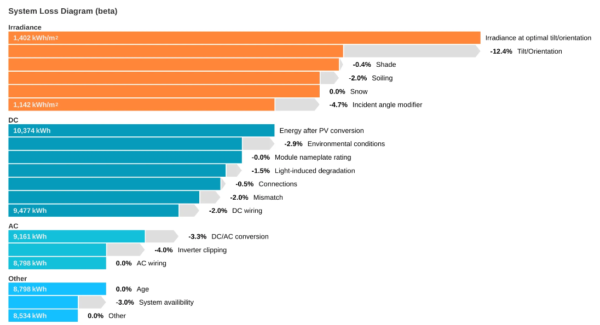Aurora Solar offers guidelines to make the most of a solar installation by avoiding losses.
When investing in solar, maximizing production is a common goal. Aurora Solar, a leading solar design and performance software provider, released a guide for understanding the leading causes of energy loss in PV systems, and how to avoid them.
KWh Analytics, a climate insurance and renewable energy risk management firm, released its 2022 Solar Generation Index and reports that solar assets are broadly performing below expectations. Systems installed since 2015 have broadly underperformed expectations by 7% to 15%, with some regional difference. How can this underperformance be avoided?
Aurora Solar’s Ultimate Guide to PV System Losses includes basic solar performance concepts like the effect of tilt, orientation, and shade on production metrics. The guide walks through how mismatched equipment can cause losses and surveys the effects of incident angle modifiers, and module nameplate rating losses.
Tilt and orientation
The angle of panels affects the amount of solar irradiance the system receives over the course of a year. Tilting the array towards the equator will maximize incident irradiance, boosting production, the Aurora report notes.
Making the most of the solar incidence angle is important for production, too. Incidence angle refers to the angle of the panel’s surface compared to the sun’s rays. Incidence angles affect the amount of sunlight that gets through the glass on the front of the panel.
Aurora said that these losses, measured as the incident angle modifier, typically range between 3% to 4.5%. The DeSoto model is used to understand incidence angle modifier effects.

Soiling, or the buildup of dust and other debris on the surface of the panel, is a leading cause of energy loss in some regions. In areas with long dry seasons, it can lead to 5% losses. In regions with frequent dust deposits, it can add 1% to 2% to that figure, and locations near major traffic areas typically have another 1% in losses. In regions with year-round rain, soiling losses typically hover around 2%, Aurora said.
The National Renewable Energy Laboratory (NREL) performance parameters suggests a 5% typical soiling loss in the United States is common. An NREL model found that having one annual cleaning on a system with 1.9% soiling loss would decrease the loss to around 1.5%. Two cleanings per year could drop the average loss to 1.3%, and three cleanings per year would reduce it further to a 1.2% average annual loss. An NREL locational analysis on soiling effects can be found here.
Birds and bird droppings are another production concern. Bird droppings substantially block one or two cells and may not wash away with rain. In modules without bypass diodes, one or two cells being entirely blocked could lead to the entire module losing operation. Aurora advises quick manual cleaning of bird droppings.
Snow loads are another mitigating factor. An NREL study calculated losses ranging from 10-30% for fixed-tilt systems. Snow factors can be difficult to model accurately on an annualized basis, so Aurora recommends measuring on a monthly format. A locational study on snow loss estimates based on various panel tilts can be found here.
Shading is another critically important aspect of system performance. Aurora likens a shaded solar cell to a clog in a pipe. When a cell is shaded, the current through the entire string of cells is reduced. Panels integrate bypass diodes, which allow the array to “skip over” the shaded cell, but at the expense of foregoing any production that could have been harvested from that cell. A Stanford University analysis of shading effects can be found here.
Aurora suggests using module-level power electronics (MLPE) or microinverters to avoid losses from shading.
Part of the article excerpted from the network, infringement contact deleted.